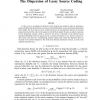Free Online Productivity Tools
i2Speak
i2Symbol
i2OCR
iTex2Img
iWeb2Print
iWeb2Shot
i2Type
iPdf2Split
iPdf2Merge
i2Bopomofo
i2Arabic
i2Style
i2Image
i2PDF
iLatex2Rtf
Sci2ools
CORR
2011
Springer
2011
Springer
The Dispersion of Lossy Source Coding
In this work we investigate the behavior of the minimal rate needed in order to guarantee a given probability that the distortion exceeds a prescribed threshold, at some fixed finite quantization block length. We show that the excess coding rate above the rate-distortion function is inversely proportional (to the first order) to the square root of the block length. We give an explicit expression for the proportion constant, which is given by the inverse Q-function of the allowed excess distortion probability, times the square root of a constant, termed the excess distortion dispersion. This result is the dual of a corresponding channel coding result, where the dispersion above is the dual of the channel dispersion. The work treats discrete memoryless sources, as well as the quadratic-Gaussian case.
| Added | 13 May 2011 |
| Updated | 13 May 2011 |
| Type | Journal |
| Year | 2011 |
| Where | CORR |
| Authors | Amir Ingber, Yuval Kochman |
Comments (0)

